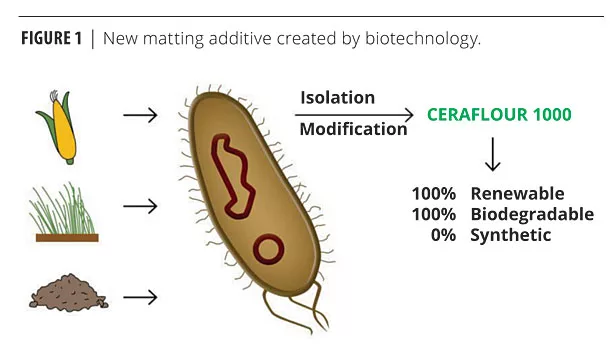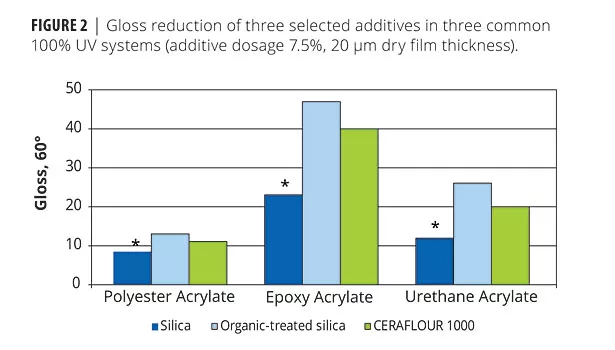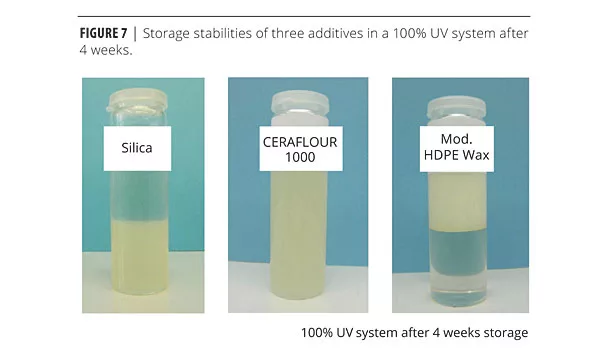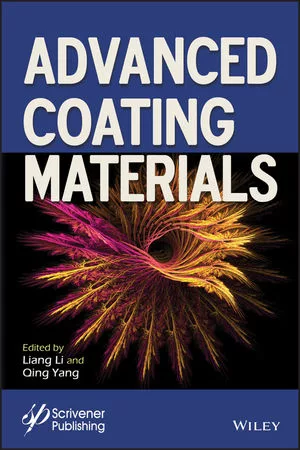A Novel Biopolymer-Based Coating Additive







Increased public awareness concerning sustainability and the preservation of nature has led to a high demand for eco-friendly products and even to new regulations. Thus, the need for innovative and so-called “green” solutions is greater than ever, and challenges all the components of a coating formulation, even if only used in small quantities. Biotechnology opened the door to an entirely new matting additive with an unprecedented combination of properties compared to conventional matting agents, such as waxes and silicas. The new additive is based on a biopolymer, which is obtained by bacterial fermentation from sugars. The biopolymer-based product originates from renewable resources, is fully biodegradable and GMO (genetically modified organism) free (Figure 1).
Matting of Coatings
Over the last several years, the development of solvent-free formulations has been intensively pushed within the perspective of realizing more eco-friendly products. The omission of solvents results in new challenges. While conventional coatings are relatively easy to matte because the film shrinks upon hardening due to emissions, solvent-free systems, such as 100% UV-curable systems, are notoriously difficult to matte.
Silica matting agents are very common and efficient in most coating systems. The amount of silica needed in solvent-free systems, especially for deep matte coatings, is significantly higher than in other coatings. Standard silica matting agents often cause a strong increase in viscosity and add additional thixotropy. Thus higher amounts of reactive diluents are needed or specially designed wetting and dispersing agents have to be used in order to reduce the viscosity, to give a Newtonian flow behavior and to provide anti-settlement properties. There are also many organic-modified silica matting agents available that do not influence the viscosity significantly, but these are less efficient in gloss reduction and often exhibit foam stabilization and less transparency.
In general, wax additives do not influence viscosity as much as silica, but they are not efficient enough to achieve low-gloss surfaces. With some amide waxes, negative side effects like foam stabilization and haziness are observed as well. The benefits of using wax additives like modified HDPE are improved film properties, such as mechanical resistance. Often, wax additives are used in combination with silica because of improved film properties like scratch and abrasion resistance. Furthermore, polymer matting agents are likely to be used because of easy incorporation and little influence on viscosity. Nevertheless, they often don’t achieve the desired performance. Following are the results obtained with the novel biopolymer-based additive.
Matting Efficiency in 100% UV Systems
The matting performance of the new bio-based product was tested in three different solvent-free UV systems: a polyester acrylate, a polyurethane acrylate and an epoxy acrylate containing a photoinitiator and DPGDA as reactive diluent. Untreated and treated silica were tested for comparison. The matting agents were incorporated in the formulations with a dissolver, and after 24 h the formulations were applied with a bar applicator on contrast cards and cured with a mercury vapor lamp (120 W/cm, belt speed: 5 m/min). The gloss of the cured films was measured with a micro-Tri-gloss from BYK-Gardner at an angle of 60°.
The matting efficiency of the novel micronized biopolymer, which was commercially launched as CERAFLOUR 1000, showed excellent matting with no detrimental influence on viscosity. For example, an amount of 7.5% biopolymer compared to 7.5% non-treated silica showed a viscosity increase from 500 to 550 mPa.s in contrast to 500 to 3000 mPa.s in a polyester acrylate system. Compared to treated silica, the matting efficiency of the biopolymer was higher or equal in common UV systems (Figure 2). In polyester acrylate and urethane acrylate systems the gloss could be reduced to 10-20% at an angle of 60° with 7.5% of added biopolymer-based additive. This is comparable to non-treated silica and better than treated silica.
The incorporation of the biopolymer-based additive is easy; no high-shear force is needed. During incorporation, dust and foam stabilization were not observed.
Matting Uniformity
In UV systems a uniform gloss is commonly a big challenge. Small variances in film thickness can generate gloss differences. The polyester acrylate described above was applied with different film thicknesses and the gloss was measured. In contrast to other matting agents, such as treated and non-treated silica, and wax and organic polymer, it was observed that with the novel additive, the gloss level was fairly independent of film thickness (Figure 3).
The additive has also been tested in systems other than 100% UV. In many waterborne 1K, 2K and UV systems good matting efficiencies were observed. In most cases results similar to conventional matting agents were obtained. In solventborne systems the matting properties were better than with wax additives, and in some cases were like silica. Combinations of the biopolymer with silica, polymer matting agents and wax additives are possible.
Clarity
Generally, a transparent coating is defined as capable of transmitting light so that objects or images can be seen as if there was no intervening material. When incorporating a matting agent into a coating the light that passes through the coating is partially scattered. Our visual perception can clearly differentiate between wide-angle scattering and narrow-angle scattering. Wide-angle scattering diffuses light in all directions and leads to a loss of contrast, also known as haze. Narrow-angle scattering diffuses light in a small angle range with high concentration. It impacts how fine details can be seen through the specimen, or in other words, it describes the clarity or see-through quality.1 High clarity is desirable for wood coatings: the graining of wood should be clearly visible.
In order to evaluate coating clarity, the new bio-based additive was compared to organic treated silica, amide wax and modified HDPE wax. The matting agents were incorporated with a dissolver into a 2K solvent-based polyurethane system, and after 24 h the formulations were poured onto PE foils. The clarity was measured using a haze-gard plus (Figure 4).
The haze value of the prepared films, also measured with the haze-gard plus, was 7 for the control, 22±1 for the coatings with amide wax, modified HDPE wax and the new bio-based additive, and 37 for the organic-treated silica. The biopolymer-containing film showed a higher clarity in comparison to treated silica or wax-containing films, thus the biopolymer additive is particularly suitable for coatings with reduced gloss accompanied with a high see-through quality.
This high transparency was also observed in 100% UV systems and in water-based coatings. The orientation of the particles was very homogeneous in all systems.
The cross-section of films, prepared with a draw down on contrast cards with the above-described 2K solvent-based polyurethane system, was investigated by scanning electron microscopy. The images show a uniform distribution of the particles throughout the cross-section of the final coating (Figure 5).
Haptic Properties
The haptic properties of an object describe the sense of feeling and are a popular field in research. It is becoming increasingly important from a product’s competitive point of view. The haptic properties can be adjusted by the properties of the coating. Good haptic is, in our definition, a smooth surface with a soft-touch effect. In order to test the haptic properties, several samples based on polyester acrylate binder containing a photoinitiator and DPGDA as reactive diluent were prepared. Silica, organic-treated silica, amide wax, modified HDPE wax and the new bio-based additive were used as matting agents. The coating was applied with a bar applicator to give a dry film with a thickness of 20 µm. There is, however, no equipment for testing haptic properties of coated samples. A number of individuals were asked to evaluate the samples by feeling them. The coating containing the bio-based additive was consistently judged as the smoothest and most pleasant. It is noteworthy to say that the improved haptic properties don’t generate an increase in slip. The coefficient of friction of the coating with and without the biopolymer was similar.
Coating surfaces were examined in more detail using a confocal 3D microscope (MicroSpy Topo DT from FRT GmbH). Representative images revealed differences in surface roughness and structure (Figure 6). The coating containing silica, which has the roughest touch, had a regular distribution of fine elevations at the surface. On the other hand, the coating containing the biopolymer-based additive, which has the most pleasant touch, was characterized by regular distribution of coarse elevations.
Easy Incorporation and Storage Stability
As already indicated above for the polyester acrylate system, the biopolymer-based additive is, in general, easy to incorporate into all types of coating formulations without the formation of dust or the stabilization of foam. Additionally, good storage stability was observed in all kinds of systems. In this respect, the bio-based additive was added to a coating formulation and stored for 4 weeks at elevated temperatures. Applied coatings before and after storage presented the same low gloss values, and neither seeds or hard settlement could be observed. In 100% UV systems the biopolymer-based additive had homogeneous in-can distribution, also after storage. In comparison, silica tends to settle and wax creams, as shown for a 100% urethane acrylate system (Figure 7).
Improved Film Properties
In general, the applied films containing the biopolymer-based additive showed good leveling. In addition, it was observed that the additive may improve the scratch and abrasion resistance of a coating. In this respect, the additive was incorporated into a system based on an acrylate dispersion. The applied films were subjected to different test methods, such as the SATRA rub test or the Taber abrasion test. Regarding the enhancement of the mechanical film properties, the biopolymer-based additive performed better than silica and polymer matting agents, but was inferior in comparison to a modified HDPE wax. Combinations with modified HDPE wax are recommended to achieve additional improvement of mechanical resistance. With the biopolymer-based additive, burnishing or polishing effects and finger marks were not observed.
Summary
An innovative biopolymer-based additive with an excellent combination of properties was developed. The product is 100% based on renewable resources and is completely biodegradable under normal conditions, such as landfills, with zero toxic waste, as it is ultimately converted into carbon dioxide and water. The key benefits are excellent matting efficiency, especially in UV systems, combined with high transparency and a warm, smooth haptic feel without influence on slip. Additionally, the additive improves scratch, abrasion and blocking resistance. It can be used in solvent-free, solventborne and waterborne systems without detrimental influence on viscosity. Easy incorporation without dust formation and foam stabilization is combined with good storage stability of the coating systems.
Reference
1 www.byk.com, Instruments, BYK-Gardner catalogue, or http://www.byk.com/en/support/instruments/downloads/catalog.html.
Looking for a reprint of this article?
From high-res PDFs to custom plaques, order your copy today!





